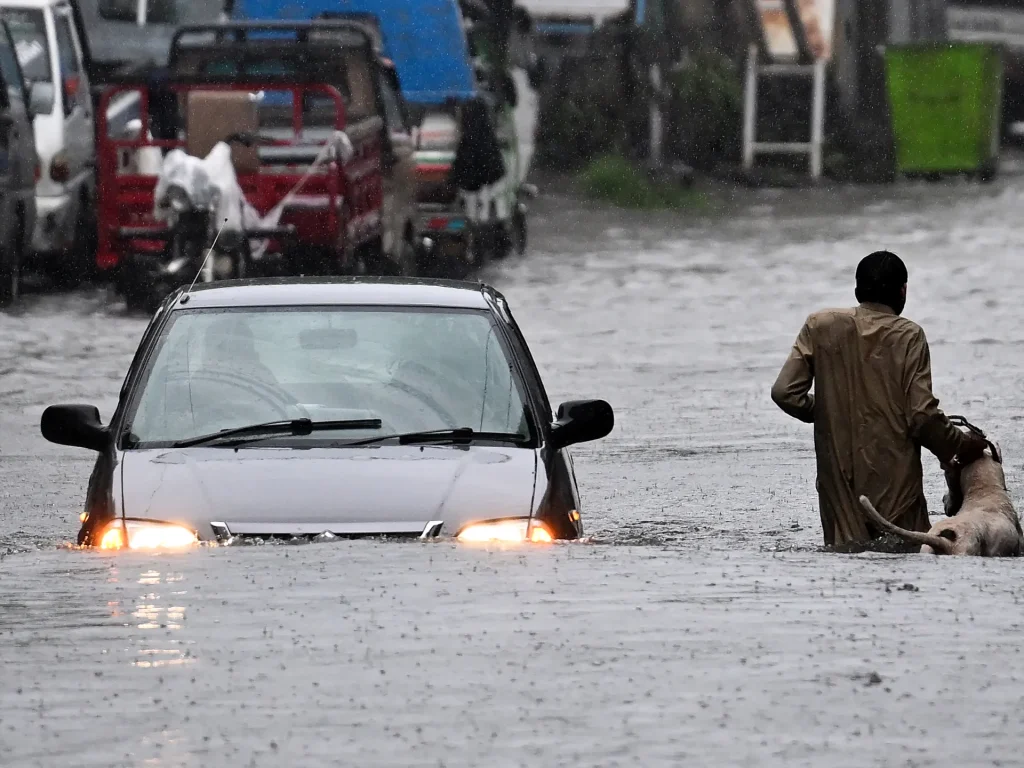As the monsoon season tightens its grip on Pakistan, the country finds itself in the throes of one of the most destructive natural disasters in recent years. With consistent, unrelenting rainfall over the past few weeks, the death toll has surged to 279, while 676 individuals have been injured across the nation. The human toll, however, only scratches the surface of the devastation left behind by the powerful monsoon system.
Punjab Faces the Harshest Blow
The province of Punjab has emerged as ground zero of the crisis. With 151 deaths and 536 injuries, it accounts for more than half of the total casualties reported nationwide. The recent spell of rain brought even more damage, claiming six additional lives and injuring dozens in just the past 24 hours.
Streets in Lahore, Faisalabad, Gujranwala, and Sialkot have turned into rivers, swallowing vehicles and cutting off access to homes, schools, and hospitals. Urban flooding has overwhelmed the sewerage and drainage systems, many of which were already outdated and ill-equipped to handle this scale of precipitation.
Entire low-lying neighborhoods are submerged, forcing thousands to evacuate with only the clothes on their backs. Many are now sheltering in schools, mosques, and temporary government relief centers, unsure of when they will return to their homes if at all.
Widespread Damage Beyond Punjab
The destruction is not confined to a single province. The rest of the country is also grappling with the monsoon’s fury:
- Khyber Pakhtunkhwa has recorded 64 fatalities, with flash floods sweeping through mountainous valleys and damaging rural infrastructure.
- Sindh has reported 25 deaths amid rising water levels in key districts, particularly around Karachi and interior Sindh.
- Balochistan has suffered road collapses, landslides, and 20 confirmed deaths as floodwaters wreak havoc across remote regions.
- Gilgit-Baltistan, Azad Jammu & Kashmir, and Islamabad have also seen casualties and critical damage to homes and essential services.
Damage to Homes, Infrastructure, and Livelihoods
Over 1,553 homes have been either partially or completely destroyed. In rural communities, this means not just the loss of shelter but also food stocks, stored harvests, and livestock key sources of sustenance. So far, 374 livestock animals have perished, devastating the livelihoods of many small-scale farmers who rely on these animals for income, milk, and labor.
Bridges have collapsed. Rural roads have washed away. Power lines dangle precariously. In many affected districts, residents have been cut off from food, clean water, and medical care for days. Helicopters and boats are being used to reach isolated communities, but persistent rains are slowing down rescue efforts.
Meteorological Outlook: More Rains Expected
Weather authorities have warned that the worst may not yet be over. A new wave of monsoon rain is expected to continue through July 31, with forecasts predicting intense downpours in Murree, Rawalpindi, Lahore, Sialkot, and Galiyat. The threat of flash floods, urban flooding, and landslides looms large, especially in hilly terrain and overpopulated urban centers.
Emergency advisories have been issued in multiple districts, with residents urged to evacuate where possible. Unfortunately, many low-income families living in informal housing settlements lack the means to relocate.
Rescue Operations in Overdrive
Despite the challenging conditions, rescue operations are underway around the clock. Thousands of first responders, including Rescue 1122 units, army personnel, paramedics, and civil defense teams, are working to evacuate families, treat the injured, and distribute food, drinking water, and blankets.
Temporary relief camps have been established, but overcrowding and shortages of supplies remain a concern. Sanitation conditions are rapidly deteriorating in many shelters, raising fears of waterborne diseases such as cholera, typhoid, and dengue in the days ahead.
Mobile health units have been deployed in high-risk zones, but flooded roads and communication outages are hampering efforts. Boats are being used in severely affected areas to deliver medical aid and evacuate stranded citizens.
Economic and Psychological Fallout
The economic cost of the floods is expected to run into the billions. Damage to crops, livestock, homes, and transportation systems will ripple through the national economy, especially in rural areas that rely heavily on agriculture.
Beyond the economic toll, the psychological impact on survivors is profound. Children have been pulled from schools. Families are living in uncertainty and fear. Thousands have lost not just possessions, but loved ones. The trauma of displacement, injury, and witnessing destruction firsthand will leave lasting scars.
Need for Structural Reform and Climate Resilience
As the floodwaters rise, so too does the urgency for structural reform. Pakistan remains one of the world’s most climate-vulnerable countries, yet disaster preparedness, urban planning, and climate adaptation remain underfunded and overlooked.
Experts warn that unless systemic changes are made including:
- Building climate-resilient infrastructure
- Expanding flood diversion canals
- Enforcing zoning laws
- Digitizing early warning systems
this cycle of death and destruction will repeat with increasing frequency and intensity.
The time for reactionary measures has passed. What’s needed now is a long-term, well-funded national strategy that prioritizes climate resilience, environmental planning, and community preparedness.
Conclusion
Pakistan is once again facing the devastating consequences of unchecked climate change and underprepared infrastructure. With 279 lives lost and hundreds more at risk, the monsoon of 2025 is a tragic reminder of the urgent need for national resilience. While rescue efforts continue, and the skies show no signs of mercy, the hope lies in rebuilding not just homes but systems that protect the people within them.



Comments (0)
No comments yet. Be the first to comment!
Leave a Comment